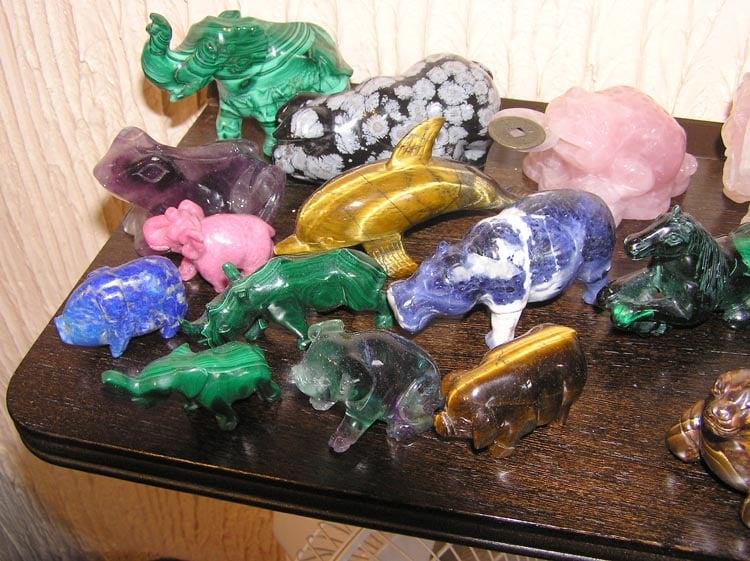Professional Gemologist Certification Course
An Introduction to the Lapidary Arts
Purchase Professional Gemologist Certification Course
The International Gem Society (IGS) was one of the first online schools of gemology to serve a global audience. Our goal is to provide a flexible and affordable education in gemology. IGS's founder, Donald Clark, CSM IMG, created a robust testing process to ensure that those with IGS certification would stand out in the crowd. IGS continues to use the testing process created by Donald Clark to ensure continuity and rigor.Other lapidary techniques include combining gem materials to create inlays and assembled gemstones as well as suiseki rock artistry. In this guide, we'll introduce the four basic fields. You can learn more about each of these lapidary arts in the Fundamentals of Lapidary series.
Gemstone Tumbling
The simplest form of lapidary, gemstone tumbling requires minimal equipment. You put rough gem material into a tumbler, a revolving barrel with abrasives. Progressively finer abrasives are used until the gem obtains a polish. This process closely resembles what happens to rocks in a stream or on the beach. However, tumbling produces much higher polish levels.
Is Gemstone Tumbling Suitable for Children?
Ideal for children and a great family pastime, it's a great way to work stones collected on family vacations or rock hunting. Plus, the results are sensational! You can also purchase inexpensive settings and turn tumbled stones into jewelry pieces. They make wonderful homemade gifts.
Cabbing
Cabbing or cabochon cutting is probably the most common form of lapidary arts. Cabochons or "cabs" are gems cut with a flat bottom and a curved or domed top. If you've seen opal or turquoise jewelry, you've probably seen cabs.
Can You Make Money Cabbing?
Cabbing can be profitable. Depending on the gem material you use, cabochons can have significant resale value. Thus, cabbing can make a very rewarding hobby, especially if you cut gems you find yourself. However, cabbing machines do cost more than tumblers. While cabochon cutting is more complex than tumbling, you can become proficient with a little practice. A word of warning: cabbing can be highly addictive!
Faceting
Of all the lapidary arts, gem faceting has the greatest profit potential. If you can imagine a diamond in a typical engagement ring, you're likely visualizing a faceted gem. Geometrically arranged, flat surfaces typically cover the surface of such a diamond. Each of these flat surfaces is called a facet.
Faceting should bring out the brilliance of a gem. The bottom facets reflect the light entering the stone and return it to the viewer. (Don't confuse brilliance with dispersion or "fire," the multicolored flashes you see coming out of diamonds and some other gems).
Faceters facet gems on faceting machines. You can find many different kinds for sale. Whether you want to facet gems for fun or profit, prepare to make a significant investment in equipment. When faceting, more so than the other lapidary arts, your equipment quality will affect both your results and your enjoyment.
Is Gem Faceting an Art?
There are also many kinds of faceters. Faceting is an art, but you don't need some esoteric "artistic sense" to engage in it. Machinists, engineers, and those with a knack for math often excel at faceting. Many faceters are semi-professionals. They sell enough gems to support their hobby or supplement their income. For those interested in collecting or investing in gems, faceting is by far the most practical lapidary art to learn. The wholesale price of the finished piece almost always exceeds the cost of rough gem material and labor.
Although you can become skilled at faceting with minimal experience, you'll never run out of new challenges.
Carving
Carving is the most challenging of the lapidary arts. There are very few recognized experts in the field. To succeed at gem carving, you do need a distinctive artistic sense and a thorough understanding of lapidary principles. More so than wood or metal, gem material presents definite limits to what you can carve.
What are the Types of Gem Carving?
There are several types of gem carving. One of the best known forms is cameo. Gem carvers usually cut them from sea shells or agates. However, almost any material may work. Cabochons are often carved, too. If the design is cut into the top of a cab, it's called an intaglio or relief carving. If the design is carved on the back, it's a reverse intaglio. Some carvings aren't designed to be used in jewelry. Carvers cut these stand-alone carvings simply for their beauty.
Donald Clark, CSM IMG
Donald Clark, CSM founded the International Gem Society in 1998. Donald started in the gem and jewelry industry in 1976. He received his formal gemology training from the Gemological Institute of America (GIA) and the American Society of Gemcutters (ASG). The letters “CSM” after his name stood for Certified Supreme Master Gemcutter, a designation of Wykoff’s ASG which has often been referred to as the doctorate of gem cutting. The American Society of Gemcutters only had 54 people reach this level. Along with dozens of articles for leading trade magazines, Donald authored the book “Modern Faceting, the Easy Way.”
International Gem Society
Never Stop Learning
When you join the IGS community, you get trusted diamond & gemstone information when you need it.
Get Gemology Insights
Get started with the International Gem Society’s free guide to gemstone identification. Join our weekly newsletter & get a free copy of the Gem ID Checklist!
